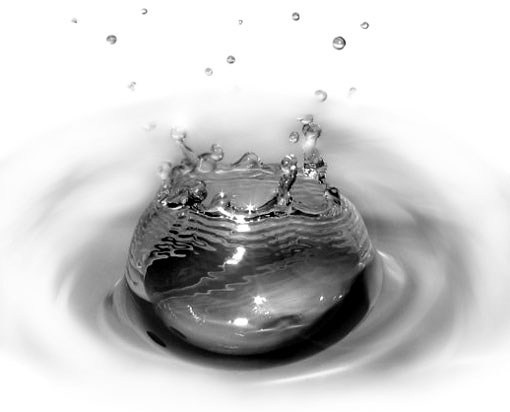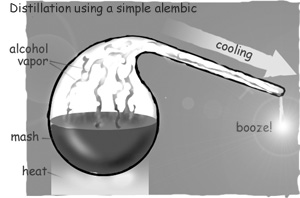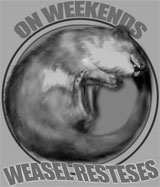Get it offa me! Get it offa me!
Yipe! I’ve been tagged with a meme. I’ve been dreading this moment. At least this one doesn’t ask any questions about CD’s I’ve bought or books I’m reading. That would be embarrassing. This one is eight habits or facts about my favorite topic: me.
1. Fact: I can wiggle my ears. In fact, I can wiggle each ear individually. In fact, my head muscles are preternaturally mobile, like a tabby. If I spot someone I don’t like, my whole scalp dances involuntarily.
2. Habit: I have a song I sing to my lima beans. The lyrics go, “lima beans, lima beans, limabeanslimabeanslima beeeeeeeeeeeans.” This is so onerous, I usually end up having peas instead, even though I really like lima beans. I don’t have a pea song, thank goodness.
3. Fact: I have ugly, gnarly feet. My mother used to say, “never mind, honey. Peacocks have ugly feet, too.” Yeah, but peacocks have a glorious fan of blue iridescent feathers sticking out of their butts. What do I have?
4. Habit: just inside the door, there’s a bowl that I empty my pockets into the moment I walk into the house. Keys, glasses, watch, small change, post-it notes. Sometimes I poke through the old notes. They are like messages from another planet. I seldom have any idea what they mean or who those people are I was supposed to call. And yet…they all sound so urgent and important.
5. Fact: I used to have double-jointed thumbs. I could grab either thumb and push it all the way forward until it touched my inner forearm, or all the way backward until it touched my outer forearm. I just tried to do it for the first time in years. I can’t. And it hurt like a bastard. Also, I read the article at the link and it scared me.
6. Habit: On weekends, I put chocolate, cinnamon and flaked chili into my coffee (fact: it makes me poop like a goose).
7. Fact: I have one of those preposterous 10-syllable cornpone Southern names. Thanks, Mother. She said she thought I might want to take up acting someday. In Foghorn Leghorn cartoons, apparently.
8. Habit: when I get down on all fours to play with Damien, he periodically turns around and waggles his ass-end at me. I finally figured out he was feigning a scent-mark. I thought maybe a puff of air on his nethers would startle him out of the impertinent habit, but after the first couple of times, he actually developed a taste for it. Now he waggles his ass and backs toward the stream of air. I can’t help myself. It’s howlingly funny.
Yes. That’s right. I go home at night, get down on all fours, pucker up and blow on my cat’s rectum. And it’s really nobody’s business.
Errr…thanks Geoff. Hm. I’m going to tag-back BONGO MIRROR and whitishrabbit out of pure vindictiveness.
July 16, 2007 — 11:29 am
Comments: 25
Let’s talk whiskey!

I love whiskey, which makes me feel pretty stupid. All that money and snootiness and bullshit and, really, whiskey is only old stank barrel-flavored vodka. Word.
There are four factors that affect the old stank barrel flavor of whiskey:
What the alcohol is made from
How thoroughly the alcohol is distilled
The container it is aged in
How long it is aged
I suppose you could add “what sort of water it is diluted with afterwards,” but the sort of airy-fairy people who style themselves connoiseurs of the taste of water, for chrissakes, really get on my nerves. So…no. Shan’t.
What the alcohol is made from
Yeasts eat sugar and pee ethanol. Deal with it. So, you can feed yeasts on sugar or molasses (rum), or fruit (wine, brandy) or honey (mead).
Starch can be converted to sugar by enzymes released when grains are sprouted. A malt is a grain that has been sprouted to release enzymes and then heated to arrest further growth. (This is where peat comes in; the malt for some Scotch whiskies is heated over peat fires).
So that adds corn (bourbon, Tennessee whiskey, moonshine), rye (rye whiskey, rye beer), barley (beer, Scotch whiskey), rice (sake)…wheat, sorghum, millet, potatoes. Koolaid. Table sugar. Doritos. Whatever. Any old carb. Most alcoholic beverages are made from more than one of these things, mashed together into a mash.
How thoroughly the alcohol is distilled
If I were to seal you in a box, you’d soon breathe up all the air, replace it with carbon dioxide, and die in a puddle of your own filth, gasping for release. Well, that’s what happens to yeast when it reaches a certain concentration; it eats all its food and drowns in its own pee. That’s why unfortified wine has a maximum alcohol content of around 14%. In technical terms, 14% is the yeast-to-pee death ratio.

To get alcohol purer than that, you need to distill it. Turns out, that’s really very easy (and fairly illegal. Just saying). See, water boils at 212° F and alcohol boils at around 170° F. So, you heat the mash in some kind of alchemical doohickey just until the alcohol turns into vapor but the water doesn’t, then collect, cool and thereby condense the vapor until it turns back into a liquid. Voilà! The miracle of booze!
Commercially distilled ethyl alcohol is getting on for chemically pure. I know you think you can taste the difference between cheap vodka and the expensive stuff, but you can’t. And, frankly, I’m getting pretty tired of telling you so.
For the purposes of whiskey, however, too much distillation would make all that pretentious peaty, single-malty shit look pretty silly. So spirits for whiskey are distilled until they are about 95% pure.
The container it is aged in
Oak barrels, generally. Bourbon, to call itself bourbon, must be aged in new, charred white oak barrels (so does Tennessee whiskey, but its unique attribute is an initial slow filtering through a big stack of charcoal). Scotch whisky (and rum) are often aged in old bourbon barrels. Scotch is also sometimes aged in old port wine or sherry casks. One year, Sandy Claws brung me a sampler of little Glenmorangies aged in different sorts of casks; you really can taste the difference. It was de-lightful and in-toxicating.
How long it is aged
Rum can be aged for as little as a year, though it is usually longer. Whiskies can be aged for as little as three years, but again…usually more. Higher heat and humidity make spirits ‘age’ faster. As whiskey ages, alcohol is constantly escaping from the barrels, enveloping the distillery in a sweet, boozy vapor traditionally known as the “angel’s share.” By the time the barrels are opened, the volume of liquid has been reduced by as much as half. Whiskey at “cask strength” is generally 50-60% alcohol and is then diluted for bottling to 40-46% alcohol, and sometimes (controversially) filtered as well.
So, that’s it. Whiskey is vodka that has been soaking up burnt wood for a decade. Doesn’t that sound lovely?
Here’s a nice glossary. And here’s a good whisky blog. Here’s another. And here’s information on the American Whiskey Trail, as fine a way to spend a Summer vacation as a weasel ever did hear.
— 6:01 am
Comments: 22











